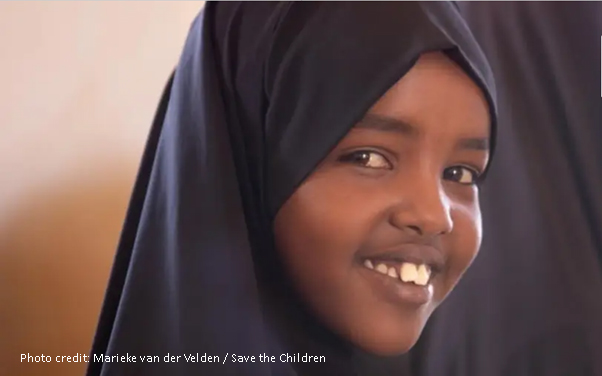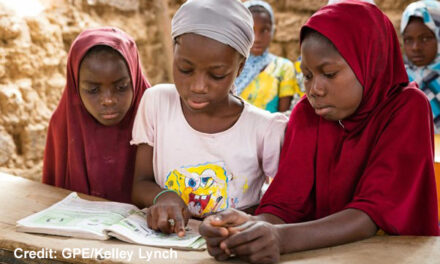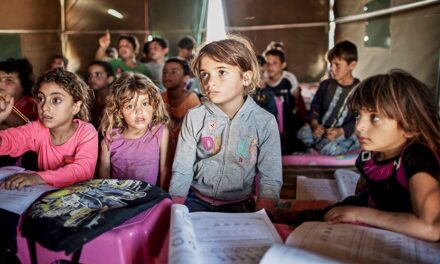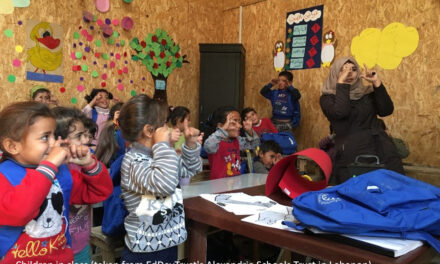This blog was written by Emma Wagner, Save the ChildrenSave the Children website
After a year of the COVID-19 education emergency, we must not forget that the pandemic has intensified the massive challenges millions of children affected by conflict and displacement already faced in accessing safe learning opportunities .
Internally displaced children – who have been forced to flee from their home but remain within their country – face numerous barriers in accessing education. While international migration and refugees make the headlines and are prominent in global debates, internal displacement is rarely viewed with the same political urgency.
Our new report Action Towards Increased Quality Education for Internally Displaced Children shines a much-needed spotlight on these children’s learning and wellbeing needs. It calls for urgent action aligned with 12 recommendations.
As of 2019, at least 12.6 million school-age children (aged 3–18 years old) were internally displaced due to conflict or violence. Periods of internal displacement are becoming longer, as years become decades, and with some children spending most of their school years displaced. A lack of resources and education documentation, and persistent insecurity, social tensions and discrimination can all limit these children’s right to safe, good-quality and inclusive education.
The COVID-19 pandemic has compounded children’s learning and wellbeing, with little access to distance learning while schools are closed. At the same time, the pandemic has increased pressures on household budgets, leading to many displaced children having to drop out of school.
Save the Children is responding by delivering education opportunities for children around the world who have been internally displaced. We also act through our role as the co-lead of the Global Education Cluster, which works to make education responses in emergencies and protracted crises predictable, equitable and well-coordinated.
When children are displaced, the case for education is amplified
Along with safety, livelihoods support and a stable home environment, education must be an integral part – not just an afterthought – in the immediate response to children’s displacement. Providing safe learning spaces can mitigate the impacts of displacement, providing a protective platform to help children and their communities secure better futures.
Governments are responsible for providing all children with an education, yet frequently it is the government that discriminates against internally displaced children and restricts their access to school. At the same time, internal displacement can place huge strains on already inadequate educational infrastructure. Even when displaced children do attend school, in many cases they do not have qualified teachers or are not offered certified examinations. States must abide by their responsibilities to respond quickly and effectively to the needs of internally displaced children. And should be supported in this by the international community.
“When we were in our village, we were hit by airstrikes, then we had to move to another area and we were hit again. We moved to a third place and we couldn’t survive because we had no support, and now we moved again in the fourth location because of the bombings. I wish I could go back to my home town and go back to school”
Internally displaced children are largely invisible in national and global data
There is an alarming lack of data on internally displaced children, which threatens to push their educational needs further down political agendas and makes planning education responses for them challenging. Lack of disaggregated data on measures such as age, gender, ethnicity and education outcomes make it difficult to understand the scale and to respond to complex needs.
What we do know is that sadly levels of internal displacement are increasing. The numbers of internally displaced people more than doubled between 2010 and 2020, to more than 50 million people.
Between January and June 2020, 14.6 million new displacements occurred across 127 countries and territories. These have been caused by conflict in countries like Syria, the Democratic Republic of the Congo and Burkina Faso, and by sudden and slow-onset climate change disasters, such as Cyclone Amphan in India and Bangladesh.
New opportunities for action
Global agreements and initiatives have the potential to reduce internal displacement and guide the response more effectively. That, includes the UN Guiding Principles on Internal Displacement, which state that every internally displaced child has the right to education.
In September, the High-Level Panel on Internal Displacement – which was established by the UN Secretary-General last year – will make recommendations to states, international agencies and civil society. It’s critical that the wishes of children are addressed.
Our recommendations to the High-Level Panel
We will not achieve education for all by 2030 unless internally displaced children are included. Our new report has 12 recommendations, based on 5 country case studies from Afghanistan, Colombia, Somalia, Syria and Ukraine.
Our report highlights that local, national and international efforts to address education for internally displaced children have grown significantly over the past decades. Yet this growth is not keeping pace with increasing displacement. A lack of national and international funding is stopping promising national policies being implemented effectively.
The lack of importance some states and members of the international community have historically accorded education for internally displaced children stands in stark contrast with the value that those children and their parents place on it.
Some of our key findings and recommendations are:
- Direct and quick inclusion of internally displaced children into the national education system can lead to greater integration with host communities and enables them to get back on track with learning.
- Governments must increase provision of child protection, mental health and psychosocial support services in alternative education programmes and in schools, and should target those children who are most marginalised.
- While it is recognised that including internally displaced people in planning and decision-making processes is essential for a good-quality and accountable response, how this is done and how children are involved varies across contexts; it needs to be more systematic.
- States, with support from donors, international agencies and the private sector, should regularly collect and share disaggregated data for internally displaced children.
- Internally displaced children must be included in responses to additional crises, including the current COVID-19 pandemic.
Read all 12 of our recommendations on education for internally displaced children in our new report.





